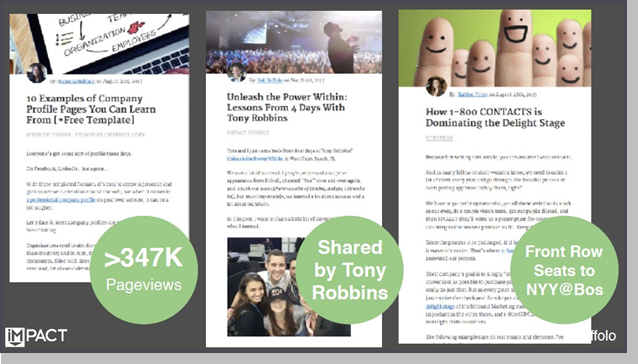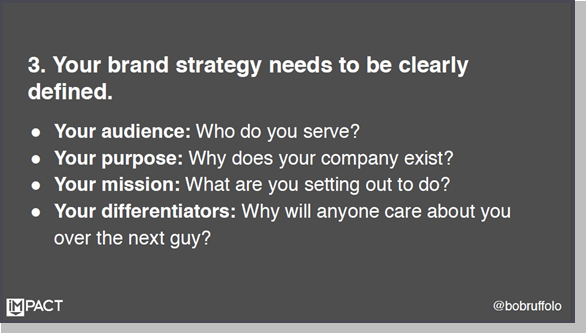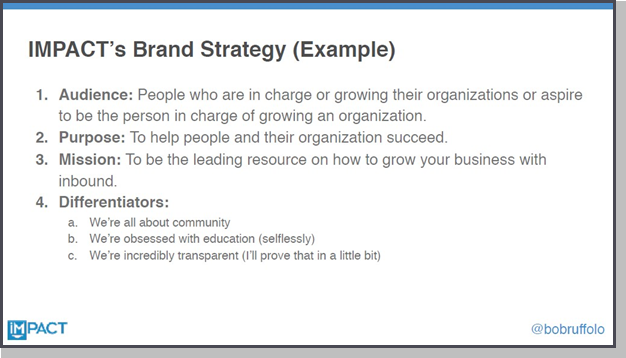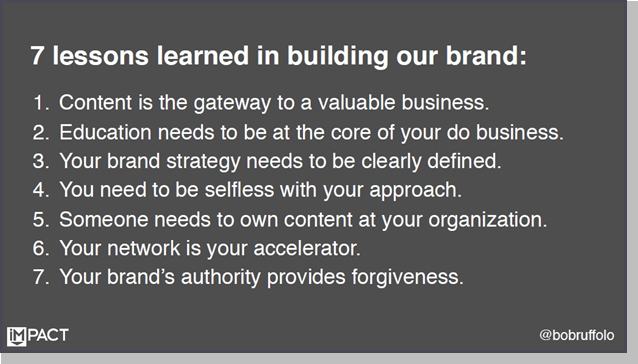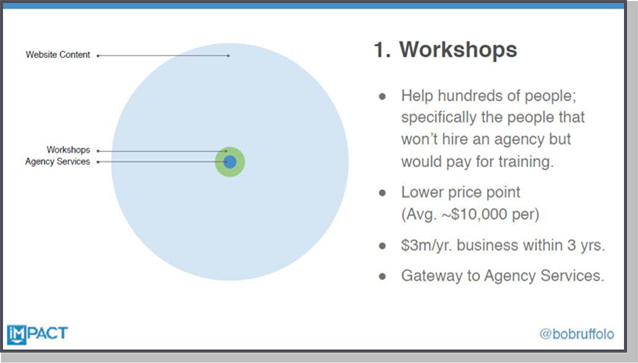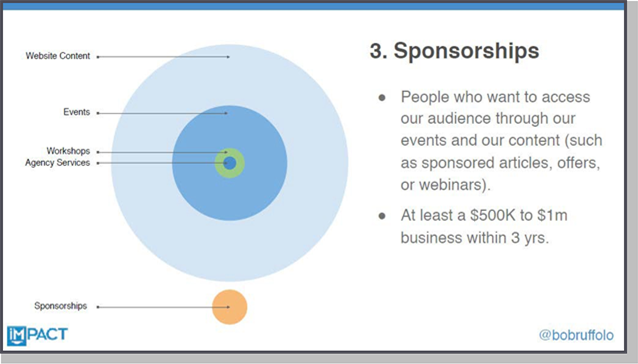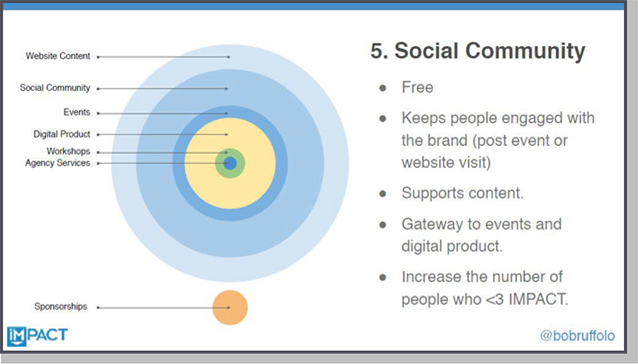Bob Ruffolo
Bob Ruffolo is the founder and CEO of IMPACT, one of the leading and most trusted resources on the topic of inbound, a DigitalMarketer partner, and HubSpot’s 2017 Partner Agency of the Year.
Before I get started, let’s clarify who this information is for, who will benefit from it. Take a look at the two logos below.
Would you classify yourself as the head honcho of your organization? Are you part of an agency? Or, maybe you’re someone who is just getting started? Obviously, my background comes from the agency perspective, but everything we be talking about definitely will cross over. The bottom line – if you are someone who wants to provide more value to your clients, customers or membership group, AND bring in more revenue, this information is for you. I’m really excited to go over this topic.
At Traffic and Conversion Summit 2018, Ryan Deiss from DigitalMarketer,
talked about three shifts he sees happening in terms of digital marketing.
Conversation is the new lead. That was the first shift he said. I very much bought into this. I’ve seen my behaviors change on websites. I’m engaging with chat a lot more. Hanging out with the founders of Drift, yesterday and hearing their vision for where the web is going. Completely bought into that one.
Skipping over to number three, Customer as the new power broker. Yeah, I agree with this. I don’t think that’s anything new, though. I think that’s something that’s been happening for years, right? The last 5 to 10 years, more power is being shifted to the buyer. One thing I do agree with him, though, is when he said it’s not the company with the best product that’s going to win, it’s the company with, that serves their customers the best.
I think the one I was most excited about, when I saw Ryan share his three shifts, is when he talked about community as the new brand. It was really interesting hear him talk about how he invested in the DM brand, and how he’s making a big bet going all in on that, and how he was trying to be the brand authority. He was doing that in a very competitive area, right? Talking about digital marketing, how competitive, but he said that he’s winning with it. It’s working.
My company, Impact, has been on a very similar journey.
Today, what I want to share with you, is our story of how we’ve worked on our community and how we’ve worked on our brand. Where
we’ve been, where we are right now, where we’re going, and how it’s completely changing our business model.
There are a lot of articles and trainings that are really tactical. Really very much in the weeds. This is not going to be that session. What I hope to do today is inspire you, to get you to focus on community, to get you to focus on brand, to fuel you with some ideas of how you can be looking at your business differently.
The Story Behind Impacts’ Success
Actually, if I go back here, I just got ahead of myself…
Impact started in 2009. I was just a freelancer. I’m sure a lot of you start your businesses as soloists, get ‘em off the ground. All I had was a laptop and a computer. I had some freelance business on the side while I had my full-time job. I worked really hard to service, worked really hard to sell. I actually had enough money that I could afford to hire somebody, get an office, continue to grow. That’s how Impact really got started.
It was about 2011 where I knew I needed to do a better job for my clients. I went online, I did a whole bunch of research. I was looking for how to drive more traffic and how to do social media better. How to turn websites into lead generators to actually get business for my clients.
Throughout that process, I, of course, landed on Hubspot’s website. I went there multiple times. I watched their webinars, I read their eBooks. What happens if you go to Hubspot’s website enough times? They call you, right? I get the call from the Hubspot rep, and he’s pitching me their partner program, saying, “You should become an inbound marketing agency. We worked with a bunch of agencies, just like you, and we 3 or 4 ‘x’ed their
growth.” I talked to them for a little while, I responded, I said, “That’s great.” So, we’re sold, I get off the phone, I look at my company, I said, “Guess what, guys. We’re going to be an inbound marketing agency, now.” They said to me, “Well, what’s inbound marketing?” I was like, “I don’t know, but we’re going to figure it out together.”
What we did was, we spent many nights just learning inbound marketing and how to do it for ourselves, and for our clients. Learning Hubspot, and how
to use the product. We had never used it before. Then we were like trying to figure out how we were going to sell all of this. How are we going to service clients? We worked really hard. Throughout our process, there’s no inbound marketing methodology at that time, so there was nothing for us to really follow. It was all so new. We, basically being visual people, we wrote out the inbound marketing methodology as we saw from start to finish. We brought it to Hubspot and showed it to my rep. I said, “Is this right?” They said, “Not only is it right, but if you turn it to an infographic, we’ll put it in our blog.” I’m like, “That’s pretty cool.” So, that’s what we did.
We created the infographic, this is what it looked like. The inbound marketing process from start to finish. Now, around the time that this happened, Hubspot was really hot. They were really getting some steam. Inbound marketing as a term was picking up. Pinterest had just come out, and that was really hot at the time, and so were infographics.
This one infographic generated over 10 thousand social shares. Immediately tripled the traffic to our website. We got our first 5 clients that were directly attributed to that. First 5 inbound marketing retainer clients directly attributed to that infographic. Beyond that, I can attribute over a million dollars of revenue, just from that one infographic.
So, I’m like, “Wow, that’s pretty cool.” This inbound marketing thing, everything I was learning about, how you create great contact, or content that’s going to attract people to your website. I’m like, “That pretty much, that works.” We were pretty excited that time, so we went all in on creating content. We had about seven people at that time. I took one person, said, “Full-time, I want you doing nothing but creating content for our company. I want you publishing two articles per day.”
What I realized was, we were the only ones in the Hubspot partner space doing that.
All our other competitors who were selling this and telling people this is what they need to be doing for their companies, they weren’t doing for themselves. It was crazy. The cobbler’s kids had no shoes. I couldn’t
understand it. We ended up having this really competitive advantage where
we got first in. We started creating a ton of different content.
In 2012, we produced over a thousand pieces of content on our website. I only know that, because I had the responsibility to audit that one thousand pieces of content recently, to find out what stuff we had to dump, and historically optimize and keep on our website. A thousand pieces of content, that never stopped. We continued that same trend in 2013, ‘14, and ‘15. The types of content we produced looked like this:
The first one is: 10 Examples of Company Profile Pages You Can Learn From [+Free Template]. This actually happens to be one of our most popular posts on our site. 347 thousand views. Our model here, as we’re looking at all this content, and billing out was, as we learn something, we just wrote about
it and shared it on our site. That was part of the reason why this content existed.
On top of that, we also watched what was going on in the industry, with software releases, and algorithm changes, and whatever else was happening. We reported on that, as well. Certainly, whenever our customers asked us questions, we would answer them. We never had a shortage of content to write about.
The second one my business partner and I went to a Tony Robbins event, Unleash the Power Within. Again, under that mindset, we learned something. There were some really good principle we learned from that event. I wrote an article — Unleash the Power Within: Lessons From 4 Days With Tony Robbins — and shared it. Tony Robbins actually shared this to his millions of followers. Again, incredible brand awareness, spiked our traffic as soon as he did that.
The third example is one of my favorite stories. Kaitlyn Petro, at our company, wrote an article called: How 1-800 CONTACTS is Dominating the Delight Stage. So, she’s a customer, she wears contacts, she had a great experience.
She basically wrote about the experience that she had and how it connects to what we do. The VP of marketing loved this article so much, he called her, sent her a whole bunch of presents, and gave her front row tickets to a Yankees – Red Sox game. Which, of course, I told her she has to bring me.
On top of that, we started thinking about our content differently, how can we be doing more video? How can we be more engaging? How can we get more people involved? Then we started a program called Website Throw Down, where people submit their websites to be critiqued live on our website. We would invite thought leaders to join us and help critique, so you could see just round up digital marketers have been on our Website Throw Down. Got Ali Gardner, George B. Thomas. We do this once a month. We’ve probably done about 30 episodes so far.
Other content we did, too is we realized there’s a problem where people didn’t know what they should be writing about. We created a little tool called, BlogAbout, which is a blog title generator. This is actually the second most popular page on our site.
Since 2011, making Impact a go-to resource in our audience was our number one priority. We just knew it was important. What happened? How did this impact our business? We basically created a fly-wheel that just keeps on turning and turning. If you’ve ever read, Good to Great, where Jim Collins talks about the flywheel? That’s how it feels.
For starters, our website has seen compound website traffic growth. To show you what our chart looks like, this is our traffic, really, really zoomed out over the years.
When we started 2011, we had about 15 thousand people come to our site that year. 2012 when we did those thousand pieces of content, we went to 134 thousand, and every year, it just compounds on that, 359, 643. 2015, 751. 2016 we finally broke a million, 1.1, almost 1.2 million, and last year we had almost 3 million people come to our website. Currently, we get about 400 thousand people reading our content on our website every single month.
On top of that, we had this organic site authority, which is incredibly valuable. Because we’ve been so committed to doing exactly what Google tells you to do is create good, helpful content. They like us, and our site has so much authority, that we can literally write a page, and put whatever key word that page is supposed to be optimized for, and there’s a very good
chance that we’re going to land on the first page of the organic results, if not
on the top three.
We had over 200 thousand people opt into our content, and we have their email addresses in our, on our mailing list.
Media mentions, all these other resources that are out there have linked to us. We’ve got all these good quality links coming into our site. Also, a lot of traffic coming into our site, so were attracting a new audience. These are just a few examples of some of the publishers that have included references to our content in their publications.
We’ve had over a thousand consultation requests last year. We’re generating about a thousand consultation requests, people that want to potentially hire us. They see our content and said, “I need help with this.” Requesting to hire us. Over 30 new clients, and our clients average about 100 thousand, so you can see, that’s what we’re bringing in per year, in terms of new business.
Speaking opportunities. If it wasn’t for our brand, it wasn’t for our community, I would never have met Ryan Deiss. I wouldn’t have met Marcus, Michael. I wouldn’t be here on this stage talking to you guys today. It’s created a lot of opportunities for you to go out and speak, really, all over the world.
I also added recruitment opportunities, here as well. Some of the best people in this space have wanted to come work for Impact because of our brand. It actually, really affects from the merger and acquisition stand point, as well. The last 12 months we did a merger and two acquisitions. We have a third one we’re working on right now. It’s been really helpful having this really strong brand that people want to associate themselves with. It’s a magnet for great talent.
Where are we now, in terms of overall business? We’re about a 6-million- dollar agency. That’s what our run rate is. We have about 50 full-time employees. And we have seven people full-time dedicated just working on our content, working on our brand. Because we are so focused on community, we build a brand with authority and we built a profitable business.
Seven Things Learned from Process of Building Impact
What did we learn from this entire process? There are seven things I want to share with you.
Lesson #1 – Educational Content
One, content is the gateway to a valuable business. Ryan Deiss shared a story in his keynote address at Traffic &Conversion Summit 2018, a golf company that had a giant audience. The Golf Channel bought them for an
exorbitant amount of money. Because that business was valuable, because it had such a large engaged audience, and such a large community.
We’ve had offers for our business, because our brand is so strong. It made our brand very desirable to be purchased. There’s a significant business value in having a big brand in the community.
Lesson #2 – Educational Content
Lesson number two. Educational content needs to be at the core of the way you do business. What I mean by this, is you have to be an educational content, or educational company first. This starts with leadership in the company. As the executives, the head honchos in your company, you have to dedicate yourself to this. This has to be your number one priority. Certainly, other things are going to come up in the business, you can’t say, “We’ll get to that later.” I hate when people think about creating content and building their brand of community as tactic, because it’s not a tactic. When you think of it as a tactic, you just delegate it to somebody. It doesn’t work, you cut it off. You never get there, you wonder why nothing’s ever working. When you make it the core of the company, it works.
I also, chuckle, too, because Ryan said something that was part of my session yesterday. He said he didn’t want it to be the Ryan Show. I couldn’t agree with him more. I don’t want our content to be the Bob Show. Everyone that works at Impact must commit to creating content, or else they can’t work there. Not only that, but the people that work for Impact truly enjoy creating great content. They’ve taken it a step further.
A few examples we have the Hubcast, which is the podcast, recently it became a video. There’s two Impactors, who do the Website Throw Down. The Impact Show, we have all these different shows. Our content has manifested in so many different ways.
We have the Inbound Success podcast. We have another brand called Market Her that just happened by three of the ladies at our organization, said they wanted to come up with a brand called Market Her. Because, this, as well, these people are creating their own content, their own sub-brand under the Impact umbrella, are now starting to get opportunities to speak around the world, themselves.
At the Inbound Conference in Boston that has 20 thousand attendees, we had five people from our company speak there. I was thinking about this, I was, all right, leadership is completely bought in, and we did this, and we had significant growth. But is it working for others? The answer is: Yes! As an example, a very good friend of mine, Pete Caputa who has been the CEO of Databox for one year, has done this very, very well.
When Pete took it over, he was 100% all in on being a educational and content company. These are the stats that he’s seen so far. He went from having five thousand monthly visitors, when he took over the company, and in one year, he went to 40 thousand monthly visitors. He’s seen a faster growth than we saw. He’s got only 19 full-time employees. He went from 12 paying customers to 467 paying customers
I asked Pete this question, “Why were you so bought in on content?”
Well, I spent 9 years at Hubspot, so that was fairly convincing. I got to watch you do what you do. I’ve been blogging since 2001,
myself, so I’ve seen the power of it. It’s gotten harder over time, but with persistence and consistency, and truly providing content that’s valuable, educational. Better than what’s out there, else wise.
Our business is fairly automated. It’s a pretty low-touch sale, so we get like two thousand sign-ups a month. We’ve been able to grow revenue by about 100 thousand of annual revenue. Every month, I think we’ll triple, quadruple that, by the end of the year. That rate. It just, it works.
Lesson #3 – Get Your Brand Strategy Right
Lesson number three, you have to get your brand strategy right. What do I mean by brand strategy? I mean you have to know your audience. You need to know exactly who you serve. You have to define that. You have
to know why your company exists, what’s your purpose? You have to be very clear about that. You need to know your mission, very clear what’s the mission of this entire initiative? Why are you different? If you don’t know
your differentiators, you’re going to have a really hard time breaking out in a existing market.
These are the four things I would identify as your brand strategy. This is what you need to give your team. If you’re going to create a culture of being educational and content company, so you can build your brand, build your community. These are the four things that you have to get right.
This is Impact’s brand strategy. Just giving you an example of what ours looks like, it’s not very long, it’s super simple. You don’t need a 5, 10, 15-page document on your brand strategy. Audience, for Impact, the people that we serve are people that are in charge of growing their organizations or aspire to be the person in charge of growing your organization. Those are the people that we serve with our content. Our purpose is to help people and their organizations succeed. We’re not limiting the market, we’re not limiting the sales. It’s to help people succeed with their organizations, however, they find success.
Our mission, when it comes to our content is to be the leading resource on how to grow your business with Inbound. The way we’re differentiated, our three differentiators, are we’re all about community. We are obsessed with education, selflessly. I’m going to get back to that word ‘selfless’, here in a second. We are incredibly transparent. I will prove that to you in a little bit.
Lesson #4 – You Have to Be Selfless
Selfless. You have to be selfless with your approach, lesson number four. As we think about content, and we think about we’re all marketers, we’re all looking for customer acquisition. It’s really hard to say, I’m going to build a content and educational program that’s helpful, but I’m always going to have CTA’s and pop-ups and all these things. Everything in my own interests.
I will tell you that 95% of the content that we produce at Impact has no calls to action, no sell. There’s a reason for that. Our brand is about trust, we want people to love us. We want people to learn from us. They’re not going to do that if they think everything that they’re consuming from us has a sales pitch attached to it, or we’re trying to manipulate them in some kind of way. It really is, truly, our brand is all about helping people. That’s why we don’t have a hard pitch in any of our content. Some content, but very little.
Lesson #5 – Someone in Organization Needs to Own Content
Five. Someone in your content needs to own, someone in your organization needs to own content. You need a content owner. In our organization, we have a girl named Ramona Sucrage. She’s been doing this for four years at Impact. She holds everybody accountable. She owns the editorial calendar. She’s working with everybody, make sure that we’re not missing any due dates. Her entire job is to make sure that the objectives that we set forth, make sure that we’re hitting 2, 3, 4 pieces of content a day.
Whatever we say we’re going to do, doesn’t get missed.
If you don’t have somebody in your organization that owns that, you’re going to run the risk of not producing the way you’re trying to produce.
Lesson #6 – Your Network Is Your Accelerator
Lesson six is that your network is your accelerator. What I mean by this is if you’re just considering starting a content program for your brand, start with the people you already know, and sell for them. It could be your best customers. It could be the prospects you’re already talking to. Create the content that’s going to excite them and hopefully they are going to want to share it.
As you continue to grow your program, and you start building more authority, then you can start using the influencers in your network. The people you’re meeting at this conference, the speakers. Maybe you have some value you can offer them by doing some co-marketing, where you’re publishing on their site, their publishing on your site. Or you’re doing some co-projects together.
Your network as your accelerator makes it go way faster. Make sure you’re focused on that.
Lesson #7 – Your Brand’s Authority Provides Forgiveness
Lesson number 7 is when you do have brand authority, it provides a lot of forgiveness to your company. What I mean by that is, when I look back at Impact, we went all in on content. We went all in on building our brand. Over the years, we stumbled in a lot of other parts of the business. We had employee turnover issues. We had client turnover issues.
Because the brand was so strong, we got a lot of forgiveness. If we messed up on a client, we still had all this great social proof, whether it be our content. Whatever it was that our clients still felt comfortable that we knew exactly what we were doing. That helped us out a lot. Even when we did screw up, we lost accounts. Because we had such a powerful engine working for us, we always were able to backflow new clients. By having a strong brand, you get a lot of forgiveness.
To recap, here are the seven lessons again:
Bolt On” Models to Add Scale, Profitability and Purpose to Your
Business
All right, that’s where we have been and the lessons we have learned. Now it’s time to talk about where we are heading.
What I’m going to talk about now, is how we’re bolting on new offerings to add scale and profitability to Impact. In reality, it’s all about better fulfilling our purpose. I already shared with you that our purpose as a company is to help people in their organization to succeed. But, I looked at what we were doing. This is probably about a year ago, and I asked myself: “Can we say that we are actually doing that?” The answer: “Yeah, that’s pretty clear.” But, were we doing enough?
At that time, our website was producing 400 thousand visitors per month, but our company was only closing about 4 new agency clients a month. We actually didn’t think it was realistic to sell more agency services to the people that were visiting our site. They just didn’t need our services. The majority
of the website visitors were either, other agencies, or people that just were never going to hire an agency.
Just give you a frame of reference, because I’m going to come back to this. At this point we were about a 3.75-million-dollar agency. That’s when we did this analysis. That got me scratching my head, right, like what should we do with this? How can we change our business so we can better fulfill our purpose, help more people do more for these people? That’s where we got this point.
We thought about this. Was our purpose to help people in their organization succeed is that only if they have 5 to 10 thousand dollars a month to spend with us. The answer was no, it shouldn’t be that as long as they have money to spend with us, then we help them.
At the same token. I was like, if our purpose to help people in their organization succeed, should we not do it if their agency is a potential competitor? Again, the answer was no, if our purpose is to help people, then even if they are a competitor, or an agency, then we should be helping them.
As we looked at our model, this is where we were. This is representing a pie. A very large audience, and we were only covering a small piece of the pie outside of content. We started thinking, okay, how can we add on to this?
Bolt On Model #1 – Workshops
The first thing we thought to do was workshops. There’s a lot of reasons
why we did workshops first. This allowed us to help hundreds of people. Expanded how many more people we could help. They might not hire an agency, but they might say, “Hey, listen, we’re doing this in-house. Can you give us a little more direction on how to do some of this stuff better?” It was a lower price point. Some of the workshops that we’re doing are averaging about $10,000. We see this becoming an additional three-million-dollar business within three years.
Not only that, but it’s also a gateway to our agency services. Maybe we go and do a workshop for somebody that would hire us for that. Then they say, “Listen, I understand what you’re doing. I can use more help in that area.” Maybe they would hire us. Our way of doing this … Does anyone know who this is? Who is it?
Marcus Sheridan. Marcus and I have been friends for a few years. We started doing some projects together. That was his entire business, was doing workshops. He speaks and he does workshops. He’s one of the best in the world at doing it. Because we had such a strong brand, and he knew he had more reach, it made sense for us to merge our companies together. Marcus is now a partner of Impact. That wouldn’t have happened if we didn’t have this large audience community. This is an opportunity for us to use that do to an M and A. Now it was a fast track for us, now offering workshops to our audience. That’s why we’re growing so fast in that area.
Bolt On Model #2 – Events
That was one thing. How could we get even bigger piece of this pie? That was the next question. That’s when we decided, let’s start doing events. We have a passion for that and we think we can help thousands of people if we start doing events. It was a much lower price point for people to come to these events. You know it’s a ticket, maybe between two and six hundred dollars. Hopefully over time that will increase. We think that this could be, easily a million-dollar business within the next three years for us. Of course, having events is a gateway to pushing people towards digital trainings, or workshops, and also to services.
This is actually the event we did last year. It’s called Impact Live. We did it in Hartford, Connecticut, August 6th and 7th. Last year we had some phenomenal speakers, Marcus Sheridan, David Meerman Scott. I was there. We had Mike Volpe and Mark Roberge, both formerly from Hubspot. Pete Caputa was one of our speakers. It was a two-day event. We’re really excited. It was 200 people last year. This year we’re hoping to do 500 people. They’ve become a big part of our business. We’re excited because it kind of fuels everything else that we’re trying to do.
Bolt On Model #3 – Sponsorships
If we’re going to do events, the next logical area we can expand is sponsorships. I kept this outside, because it really is kind of a different audience. These are the people that want to access the people that are already in our audience. We have this big brand, a big number of followers.
Now, there might be a great product, like Databox, that wants everyone in our audience to be using it, or aware of how it could help them. Now we’re starting to do more sponsorships. We’re doing it, obviously from events, but we’re also doing it with our content, where we’re going to do sponsored webinars, we’re doing sponsored content, sponsored email blasts. We’re starting to think much more like a publisher for these sponsors.
We think that this, again, can be a million-dollar business for the next three years for us. To expedite this, we put together our media kit. It has all the stuff in there, and just an example of how we’re building our sponsorship program.
Bolt On Model #4 – Digital Products
This is the next way we see expanding, is doing a digital product. We actually don’t have one, yet, but I’m sure a lot of people can tell you it’s probably already due. Again, we think this will help us help thousands of people. Much larger piece of the pie. A much lower price point, maybe it’s about $600 per year. Again, another million-dollar business on top of what we’re already doing. We think this is a very easy upsell for us to sell after our events.
Our model for this, what we’re looking to do, is to build digital content from our live stuff, and the great thing about this, it that it can be a tool to drive people to future workshops and services we offer. Our model for this, we’re going to call it Impact Live 365.
To make it really easy for us, since we’re doing the events, we’re going to take that recorded content and put it into a monthly subscription program supplemented by recordings of other workshops and things that we’re doing.
Since Impact is a certified partner of DigitalMarketer, if you’re a partner of their program, you get access to all their material as well. We’re now going to be able to put that into our digital product and supplement there. We think we can put together a nice little package that will be really beneficial for our audience that might have 600 dollars a year to spend with us, but not 10 thousand dollars or more.
Bolt On Model #5 – Social Community
The last part, number five here is social community. This is another add- on. It’s free for now. We may think about doing something that’s a little more paid later. It keeps people engaged with the brand. The reason why we did this is we have all these visitors coming to our website, but we want to have more conversations with them. Obviously, we’ve seen a lot of shifts in Facebook and Twitter, and they’re not as effective, maybe, organically as they used to be.
But, you do see a big push when you do the Facebook Groups. That’s what we did. We invested in doing a Facebook group. Certainly, supports our content that we’re trying to do. It’s a gateway, again, to everything else that we’re building, specifically a digital product and events.
In our social community, actually, the biggest idea here, too, is we’re trying to bring people to that next stage, where they’re not just aware of Impact, but they truly love Impact. That’s the metric here.
Our group is called Impact Elite. I welcome you guys all to join it. The short link there is: impactbnd.com/elite. We’ve got about 2,000 passionate marketers. I just hired a full-time person specifically to be in charge of our audience and our community, and to run this group. The idea is to continue to grow in scale, thus.
Predicted Impact of Implementing “Bolt On” Models
Now, being incredibly transparent with everybody here in this group. This is how we envision Impact will grow.
We’re already doing, last year we did that 3.7 mil in services. We continue to see that grow. We think all the other services will continue to fuel that. By adding workshops in, adding event tickets, sponsorships and digital products, we think we can double the company this year. Do 10 million the year after that, maybe do 14 million the year after that. That’s how we’re playing, that’s actually how we’re running our business.
Recommended Next Steps
If you’re reading all this, you might be saying, “Where should I go from here? What are the recommended steps for me to go back to my company?”
My recommendations for you, is document your brand strategies first. You might already know it if you’re the business owner, it’s probably in your head. Remember what I said, this is an organizational thing.
If you’re going to make this, let’s say, okay our organization’s going to be all about education. We’re going to start working on our brand. Everybody in your company needs to be aligned around the same things. If they don’t
know it, it’s not exactly the same, you’ve got to write it down. That’s your, who you serve, your audience, your purpose, your mission and your differentiators.
Step one, really easy, document your brand strategy. You can probably
bang that out right after finishing this article.
Number two, document your vision. This is one of the most important and powerful tools in our company. I could go deep into it right now, but what does your company look like in three years. Get that documented, because then you know where you’re working towards. Again, you can align your entire company around that shared vision.
Take that vision, number three, and break it down to smaller quarterly objectives. That’s, again, how we run our entire business. We break our vision down to quarterly objectives and we make a little bit of progress. Little movements towards that vision every single quarter.
The most important thing, because these things are quick. You could probably do this in a weekend. Get your team around it in a week. The next most important step is to execute. We always get caught up in being strategists, getting creative. Thinking about all the things we could be doing with our business, but then we actually don’t do anything. We get stuck.
The reason why Impact grew so fast, is because, really, overnight, we said we’re going to start doing two to three articles a day. We did the next day. Pete did the same thing when he first came up with Databox.
Immediately, he went all in on that. I challenge you guys to get going, whatever you’re going to do, get going on it fast.
- Content Inc.: How Entrepreneurs Use Content to Build Massive Audiences by Joe Pulizzi
- They Ask You Answer: A Revolutionary Approach to Inbound Sales, Content
Marketing, and Today’s Digital Consumer by Marcus Sheridan




